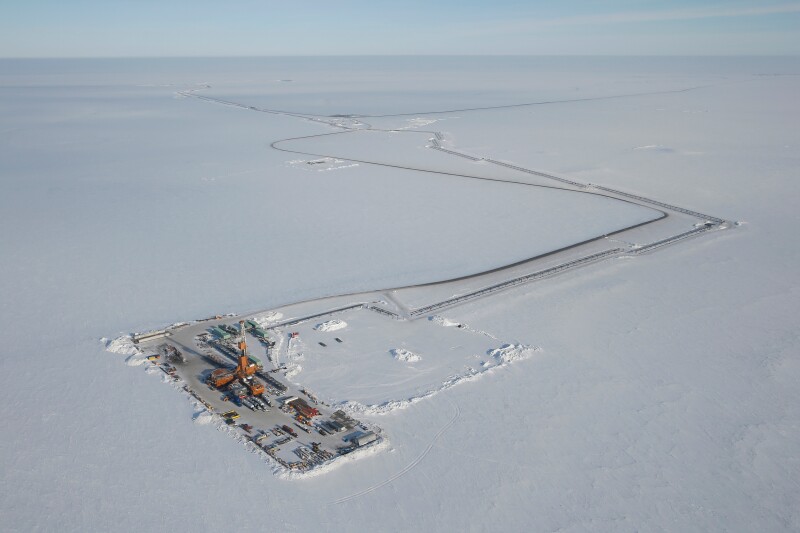The US Department of the Interior (DOI) approved on 13 March a downsized version of ConocoPhillips’ Willow project on the Alaskan North Slope, with a new record of decision (ROD) giving the green light for a three-pad development instead of the originally proposed five drill sites.
The project approval comes after years of delays and with significant modifications from the project’s initial master development plan submitted in 2018. That plan proposed up to five drill pads with up to 50 wells on each pad and supporting infrastructure.
This new ROD replaces the one received in October 2020 that was then blocked by the US District Court of Alaska in August 2021 by vacating environmental assessments previously approved by the US Bureau of Land Management (BLM) and the US Fish and Wildlife Service.
The court ordered both agencies to reevaluate the project’s effect on greenhouse-gas (GHG) emissions along with its impact on wildlife and to reissue new findings before the project could move forward.
That court-ordered draft supplemental environmental impact statement was released in July 2022, with the BLM stating in February 2023 that it found the scaled down three-pad development, known as Alternative E, as its preferred option.
“This was the right decision for Alaska and our nation,” said Ryan Lance, ConocoPhillips chief executive. “Willow fits within the Biden administration’s priorities on environmental and social justice, facilitating the energy transition and enhancing our energy security, all while creating good union jobs and providing benefits to Alaska Native communities.”
The US independent announced the discovery of the Willow oil play in 2017, saying the following year that it believed between 450 and 800 million BOE were in the play. Located in the National Petroleum Reserve in Alaska (NPR-A), the Willow project is estimated to produce 180,000 BOPD at its peak, create up to 2,500 construction jobs, and deliver between $8 billion to $17 billion in new revenue for the federal government, the State of Alaska, and North Slope Borough communities.
The DOI said that as part of the reduced plan, ConocoPhillips is relinquishing 68,000 acres of its existing leases in the NPR-A, including about 60,000 acres in the Teshekpuk Lake Special Area.
North Slope Revival
Now that the project approval has been secured, the company can progress the development while adding diversity to its large, global portfolio, according to Mark Oberstoetter, head of Americas (non-L48) upstream for Wood Mackenzie.
“Growth at Willow adds some desired diversity to a Permian-weighted portfolio, but the company has also consistently articulated its rigorous investment criteria and cost-of-supply framework,” he said. “ConocoPhillips has frequently said that anything less than the 'Alternative E' project scope for three well pads would render the Willow project uneconomic. Our independent economic model substantiates that claim.”
According to a Wood Mackenzie model, reducing the number of allowed wells from three well pads to two would have changed the project’s post-tax internal rate of return from 15% to 9.8%. It also would drop the total post-tax present value (10% discount rate) from $1.86 billion to negative $54 million. These estimates use a $60/bbl Brent long-term base case price. Development costs, transport tariffs, and the government royalties/petroleum taxes are higher in Alaska than other US oil-producing regions.
Wood Mackenzie’s calculation of the government share of revenue over the 30-year life of the project totals $15.2 billion ($4.7 billion present value discounted to 2023 at 10%), according to Oberstoetter.
“The decision is a milestone for Alaska’s upstream sector, which has had exploration success from the Nanushuk play in the past decade but has, so far, been slow to move those discoveries to development. Many of those projects are on state-administered lands, not requiring federal approval,” he said.
“A revival of North Slope production is now on. With Willow joining other projects like Pikka, new pads at Milne Point, Narwhal, Nuna, and Coyote, we see production returning to 700,000 B/D by 2030, levels last seen in 2008. Without production from Willow and these other new projects, the Trans-Alaska Pipeline System would eventually run into low-flow issues, jeopardizing all production coming from the North Slope.”
More Projects Needed
The Willow project is small relative to what will be needed to offset global demand growth and supply declines, according to Al Salazar, senior vice president at Enverus Intelligence.
“We anticipate oil demand to peak sometime in the back half of this decade. That said, demand does not go to zero in a blink-of-the-eye. The world should still consume roughly 100 million B/D in 2030,” he said, adding that “all supply additions merit some consideration as it appears the oil market isn’t overly concerned about peak demand.
“Instead, the oil markets have shifted focus to peak supply. Moreover, current supply-side themes stress under investment, OPEC is currently fending off concerns about its lack of spare productive capacity, risks to Russian supply appear biased to the downside and there is the ongoing need to offset natural declines,” he said.
Salazar sees the project as a market signal, showing how tight future supply expectations are as stakeholders are entertaining distant Alaskan barrels.
“In a 100 million B/D market, a 180 thousand B/D project is not likely to move the Brent price meter,” he said. “We believe downside supply risks—peak Permian, Russian production concerns, and lack of OPEC spare capacity—likely outweigh off-oil demand initiatives. More projects in general will be needed.”
Support During the 'Bridge Years'
The Biden administration’s decision to approve the controversial Willow project on Alaska’s North Slope is a sign of the times – governments struggling to balance the dueling priorities of energy security and the journey to a cleaner future, said Radikha Bansal, vice president for Rystad Energy.
“A seamless transition requires policies that utilize a mix of all energy sources with ongoing efforts to decarbonize existing operations while accelerating investments for a cleaner and greener future,” she said. “The approval of the three-pad development by ConocoPhillips’ is viewed by some as a prudent balancing act at a time when energy security during the bridge years of the transition becomes paramount.”
Bansal said that project will help stabilize Alaska’s falling oil production in the next couple of years, although it is significantly smaller than Willow in terms of capital expenditure and well count.
"A reversal in the state’s declining production trajectory is only possible, however, with larger projects on the North Slope like Willow replacing the natural decline on existing fields," she said.
Rystad Energy estimated the project will have a competitive breakeven oil price of less than $30 per barrel of Brent, offering a solid cushion against any potential future oil price drop The project is expected to attract investments of $7.4 billion and has a net present value of almost $3 billion.
"The revenue generated from Willow will boost ConocoPhillips’ bottom line, but it will also benefit the state of Alaska by generating jobs and federal revenue. At full production capacity, the asset will constitute 10% of ConocoPhillips’ net crude oil production globally in 2030," she said. "Considering every ConocoPhillips project expected to start up between this year and the end of the decade, Willow is set to contribute a 55% share of cumulative volumes in 2030."
ConocoPhillips Alaska said it has completed extensive preparations with key contractors and expects to immediately initiate gravel-road construction activities. The company also said it is advancing internal approval processes towards a final investment decision.


